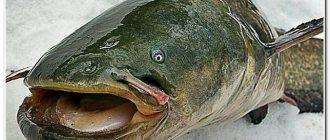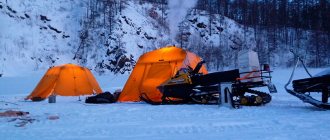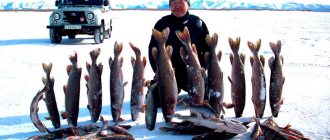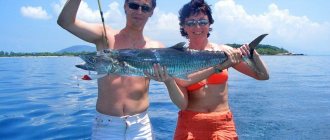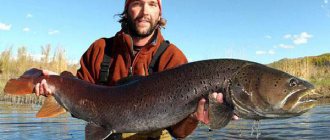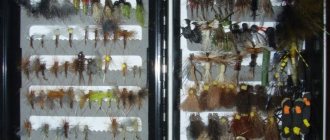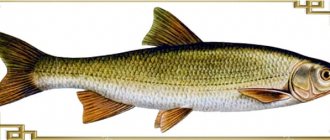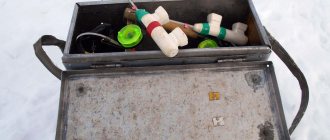Design and equipment of the girder
First, let's look at the principle of operation of the girder, learn how to properly rig it, and how to attach live bait.
Video: Fishing for pike with girders in winter, how to assemble a girder
Essential elements
The zherlitsa has many shapes and manufacturing options, whether purchased or homemade. However, the main elements (see photo) in it, as a rule, remain unchanged. This:
- base with flag;
- coil;
- fishing line;
- sinker;
- swivel;
- leash;
- hook.
Basic elements of the girder
Principle of operation
A special feature of the girder is its very simple operating principle. It works like this:
- The live bait falls into the hole.
- The fishing line of the required length is unwound.
- The spool with fishing line is fixed by bending the flag and resting on the spool of the reel.
- When the bite occurs, the pike will try to drag the bait away.
- The line will begin to unwind from the reel.
- The signaling part of the rod will be released and rise up, eventually starting to signal the angler about a bite.
By installing the girders at different depths (near the bottom, in mid-water, closer to the surface), you can significantly expand the search horizon for pike.
The main disadvantage of the hole is that the open hole can become covered with ice at any moment.
How to equip a winter rig for pike
Installation and equipment of a winter girder for pike occurs as follows:
- the required amount of fishing line is wound onto the reel;
- a sinker is attached (can be either fixed or sliding);
- A winding ring or a carabiner (swivel) is attached to attach the leash. Instead, you can simply tie an end loop. Some anglers prefer to attach the leader directly to the working line.
- a leash is mounted;
- hook(s) are attached.
Thus, there are practically no special difficulties in equipping a winter girder for pike. This work can be handled not only by a professional with significant experience, but also by a beginner who has decided to test his strength in this type of activity for the first time.
How to bait live bait
There are several options for how you can attach live bait to a girder, such as:
- For the nostrils . This method is considered one of the simplest. It involves hooking the two nostrils of a live bait fish with a single hook. In this case, you need to be as careful as possible. This is due to the possibility of damage to the nasal cavity of the fish. That is why, in order to avoid such a situation, you should choose those species that have a fairly strong head anatomy. It is best to place live bait on the girders through its nostrils if necessary, when fishing in reservoirs without a current.
- For the lips . This method is different in that it requires a certain amount of prudence. This is due to the fact that not every fish has strong lips. If the bait is large enough, over time it may break off on its own. To hook the fish by the lips, you must use only a single hook. It performs its functions better in this case. If there is no current, you can hook the bait only on the upper lip. In the opposite situation, it is recommended to thread the hook additionally through the nostril.
- For the gills . This method requires special caution from the fisherman. This is due to the fact that improper placement can cause the rapid death of the fish. If this happens, it will be impossible to interest the pike in it. In order for the process to go as correctly as possible, you need to unhook the leash or significantly loosen it. Otherwise, the live bait will be too constrained. This in turn can lead to the predator refusing to attack.
- Behind your back . This method is used by most fishermen. This is due to the fact that the fish in such a situation has the opportunity to carry out fairly natural movements. In order to ensure this, you must be extremely careful when planting. If this is not the case, the baitfish will lose the ability to move. The hook can be made behind the back either between the fin and the ridge, or directly in the area of the spine. The first method is safe for the fish, while the second is considered more reliable. Therefore, most fishermen give their preference to the second option. The hook is usually a tee.
About
Choice of live bait
Live bait should not be large so that it moves well and attracts the attention of pike. In addition, the predator can easily swallow it. The optimal size is up to 10 cm. Small perches are well suited as bait on a hook - they live a long time and behave actively on a hook in cold water. You can choose bream or roach, but they are less effective.
Live bait can be attached in the following ways:
- Through the gills. To do this, the leash is passed through the gills and out of the mouth, where a tee clings to it. An effective solution if the zherlitsa stays overnight. If a pike bites and swallows the bait, it will no longer be able to spit it out. It is recommended to make a longer leash, because... a pike is capable of swallowing not only live bait, but also a short leash, and when it reaches a thinner fishing line, it will bite through it overnight.
- Through the back, between the upper edge of the baitfish’s body and the spine. This will allow the baitfish to live longer and remain active. You can simply place the hook under the spine. But you need to be careful not to hit it and not touch the nerves, otherwise the baitfish will be motionless or will not live long.
- If the tackle is light and the hook is single, the bait can be hooked by the lip. If the current is strong, the hook can be passed through two lips.
Another possible option is behind the nostrils. It is suitable if the hook is single and involves hooking both nostrils of the fish with a single hook. You need to act carefully so as not to damage the nasal cavity of the baitfish. This method is relevant if pike are caught using girders in a reservoir without a current.
How to catch pike in winter using girders
Catching pike with girders in winter, with girders placed on the pond
In order to ensure a good catch, you first need to choose the right place for fishing. Ideally, it would be to discover the habitat of the pike. Having found a fish outlet, in one day you can catch up to 5-7 individuals of these predators and, perhaps, a large pike will be among them. This is normal for a nerd. If desired, you can also fish at night.
Where to place the girders?
In winter, pike are mainly found in the pond in ambush. From the same place she constantly watches the fish swimming nearby. As soon as the prey approaches the required distance, the predator suddenly attacks it.
It is necessary to make winter supplies and install girders in certain places depending on the type of reservoir:
- On the rivers . In this case, it is better to choose deep bays, holes under rifts, small pools, or plants above capes.
- On ponds and lakes . In such a situation, you need to navigate along the boundaries of vegetation. You can also choose places in the channels between the island and the shore. You need to pay attention to snags, cliffs and bushes.
To examine the bottom of a reservoir, it is best to use an echo sounder. If the reservoir will be visited for fishing in the future, you can use a jig or a spinner instead. In the process of examining the bottom, it is important to note for yourself various changes in depth or the presence of any obstacles. It would not be superfluous to analyze the behavior of local fishermen, since they must know exactly all the features of a particular reservoir.
About
Fishing place
It is impossible to give universal recommendations on choosing a place for fishing. Several factors come into play here:
- Availability of shelters;
- Availability of oxygen in water;
- Good visibility;
- An abundance of small fish that can be used to throw pike;
- Relative silence and a feeling of protection from fishermen.
In the under-ice twilight, good visibility will only be at a depth of up to 4 meters, and it is best to look for this predator in shallower areas. There is no point in fishing at a depth of more than 4-5 meters. In deeper areas, live bait should not be released completely to the bottom. The fact is that the pike often stands in the depths and looks out for the prey that is frolicking above. There it is clearly visible, especially since it displays a similar hunting style in the summer, when it hunts from below from under the thermocline boundary.
Oxygen is supplied to the water during daylight hours by plants, which by February have already finished dying and are beginning the next life cycle, preparing for summer. Both annual and perennial algae provide both good shelter and a source of oxygen. With the arrival of twilight, when they already begin to absorb oxygen from the water, the predator tries to leave overgrown areas.
The fisherman should first of all pay attention to “strong” places. Bushes, snags, submerged piles, logs, stones at the bottom - all these are natural shelters that, if they do not help the predator to completely hide, are capable of covering it at least partially. In such “strong” places, as a rule, there are enough small things.
However, pike prefers fairly large fish. It is capable of swallowing and digesting live bait equal to half its own weight, and live bait equal to one tenth is its usual prey. Therefore, it is not at all necessary that in the zone suitable for pike hunting there should be small fish, small fish. Quite often the predator approaches concentrations of large roach, silver bream, and even bream. A hundred-gram live bait, large enough, will be food for a kilogram predator. This size is the most common in the winter season of February.
Silence and a sense of security are another important factor. It’s quite difficult to catch a pike when holes are constantly being drilled around you. It is best to leave the place where the vents are placed, darken them and dust the traces with snow, which are also clearly visible from below. If you stomp a lot around the holes, this will create noticeably more light under the ice, and the predator will avoid such “suspicious” places. You should also remain quiet when landing fish.
Features of fishing with girders
Winter fishing can be quite varied. It differs primarily in the climatic conditions of the period when the fisherman decided to go out to the reservoir. That is why it is extremely important for both beginners and professionals to understand what the main nuances of pike fishing are in early December, January, February or early March.
On the first ice
After the icing of the reservoir appears for about two weeks, the pike does not change its lifestyle. She does not swim away from her typical habitat, continuing to hunt in them for a certain time. This is due to the presence of a relatively significant number of fry in this area. Most often this concerns edges - places where there are significant differences in depth.
Catching pike on ice rigs on the first ice can be quite effective, but being on a body of water requires extreme caution.
In the wilderness
In the dead of winter, the danger of falling through the ice is usually minimal. That is why the precautionary rules during this period of time are less strict than when the first ice appears.
The main feature of pike fishing in the dead of winter is that the predatory fish at this time goes hunting for only 20 or 30 minutes. If you miss this period, the catch may be minimal. Often after fishing you can return home with nothing.
About
Fishing with girders at the edge of the reeds
On many bodies of water, the coastline consists of endless floodplains. Practice shows that sometimes there are enough predators for almost the entire water area. However, this is rare, and it is better not to count on this. To fish consciously and have much better prospects, you don’t need much. Initially, it is worth choosing places to set up the zherlitsa that are at least somewhat different from the rest. Even with the external uniformity of the reed wall, you can see points where, say, the density of the thickets is lower or, conversely, higher. There will certainly be microbays or recesses in the reeds, where the vent will have a noticeably larger range of action. Areas with reeds protruding into the depths of the reservoir are very promising. This is a clear sign that the relief is heterogeneous, and therefore promising. In general, where the anomaly is visually visible, it is worth lowering your live bait.
The truly catchy areas are reed thickets that are located as close as possible to pits or other wintering areas of the predator, especially if such an area is small. The fish come here regularly when they are hungry. Even trophy specimens often wander in, for which swallowing half a kilo of a bee-eater is a common occurrence. Almost regardless of the type of reed and the nature of its location, I place the reed about 2-3 m from the nearest stems. Firstly, you never know how close a potential snag is under the ice. Secondly, due to the first ice, we have the right to expect that the toothy one will not be picky and will overcome several meters to the live bait without problems. Thirdly, you always need some reserve of time to catch it before the predator with live bait in its mouth ends up deep in the thickets. One option is to stop the line on the reel, allowing free play just to the reed. But even in this case, a quick reaction to a bite is required.
Fishing at the edge of the reeds is exactly the case when you have to hook immediately, as soon as the bait has worked. There are quite a few misses and hooks torn out of the mouth when hooking, but this is noticeably better than letting the bait calmly swallow and then trying to drag the tackle through the intricacies of the reeds. Since there is no gear that would be strong enough to overcome the reeds, and at the same time would not particularly frighten the pike with its bulk, it is better not to let things get caught. It helps a lot that at the beginning of winter the pike is usually playful and often captures the entire baitfish when attacking. I tend to use a small three-piece - it easily fits into the mouth of even a small pike. However, a double or a single is absolutely not meaningless. Of course, the tackle must have a greater margin of safety than when fishing at depth, because here everything happens especially quickly and almost uncompromisingly. I have had many cases when a pike bit and was directed not into the reeds, but towards the depths, but the probability of such “happiness” hardly exceeds 10-15%. I prefer fishing lines Ø0.28 mm, conventionally considering them as a kind of compromise between reliability and camouflage. I also used Ø 0.35 mm, but did not feel any benefit from it.
Since the border of the reeds is almost always quite extensive, and the pike usually manifests itself quickly, longer than 30-40 minutes. I don’t “keep” the zherlitsa in one place. Half an hour, I think, is enough for the toothy fish to move away from the noise of the ice drill, notice the baitfish, and decide to attack. This is, of course, if we are determined exclusively to fish with girders, and at a fairly active pace. In shallow water, there is an option to place live bait directly under the ice so that it is clearly visible from afar, but I am still inclined to think that it is better to present it half-water. Let's say, if the depth is a meter, then half a meter from the bottom (or a little lower). I don’t place the equipment directly above the ground, as is usually done, because near the reeds on the bottom there are often a lot of stems and other debris in which baitfish can easily hide from the pike.
If we are fishing not for a reed island or a cleverly indented coastline, but for straight sections of thickets, the fishing tactics may look like rearranging the vents in a “snake” manner. That is, we slowly move along the plants, each time moving the outermost pole forward, thereby fishing in new water areas. If everything is especially monotonous and there are no ideas, the time the live bait spends in the hole can be reduced to 20-30 minutes. However, often some anomalies are still visible in the reeds, where a pike is probably hiding. This is where you should concentrate your efforts. I do not place the girders closer than 10 m from each other. The exception is in places where bites occur regularly, and there is hope that there are a lot of pike there or they come regularly. If the edge of the reeds is near a hole or riverbed, there is a good chance of catching several decent fish at once. In general, there is only one “duty” pike in one hole. There is no need for toothy to accumulate in one area if there is already plenty of space.
It was also noticed: if there are no bites near the reeds for some time or you come across an outright trifle, most likely you will not achieve results here today or even in the coming days. Perhaps this area was somehow not suitable for the pike, even though it looks promising.
Germs in areas with remnants of vegetation
My observations regarding the presence of pike in the cold season in purely summer parking areas (grassy shallow waters) are partly contradictory. On the one hand, already in the second half of autumn, bites there are extremely rare (we are talking about spinning), on the other hand, on the first ice, these are the areas that sometimes work best. Be that as it may, fishermen with girders should not lose sight of shallow waters. There are a number of reservoirs (small, as a rule), where literally 90% of the water area is grassy shallow water with a depth of up to 2-2.5 m. There is not much choice here for both pike and pike. We calmly accept the challenge. We can say quite confidently that the most promising grassy areas are those that, firstly, are located near holes or other places where the pike would feel safe and comfortable, and secondly, are quite local and unlike the nearby terrain.
If we chose to fish in areas where in the summer the grass reached the very surface, we should not expect that now the water column, and especially the bottom horizon, will be clean and comfortable for fishing. Of course, the flora is weak now, but it remains and can easily create a lot of problems. Every now and then the baitfish will try to hide in the grass, and the pike that pecked will also head there. In addition, rotting vegetation, even in December, can create an unfavorable oxygen regime, where fish will never approach. However, this same grass serves as a reliable shelter and ambush for pikes. In my practice, there are several points when fishing in grassy areas.
1. I do not put live bait into a hole where the color of the water and, especially, the smell differ from neighboring areas (especially for the worse), and also where algae rises into the freshly drilled hole along with the slush. If they are under the ice, they will be even more so in the thickness. 2. I do not leave the girder, which has not shown itself in any way, for a long time in the same water hole. Firstly, as in the case of fishing near the edge of the reeds, it is not rational to wait a long time for a bite, and secondly, there is a very high chance that the bait fish has long since hidden itself in the grass, having “switched off” the gear from its work. 3. If there is no result, I don’t “rest” in grassy areas for too long. It is not uncommon for pike to simply not be found in the thickets. Then we have nothing to do there. 4. Taking into account the fact that the depth is shallow and the noise travels well through ice and water, I exclude any unnecessary walking with the pike overhead. And if in the summer the roar of a boat engine sometimes turns on a predator, then the running and “elephant stomp” in the winter is unlikely. 5. If there is nothing special nearby (channel edge, snags, etc.), I place the girders in a checkerboard pattern with a step of 10-20 m. If there are no bites, I rearrange them after about half an hour. I start with the distant ones, bypassing the rest of the girders. 6. In some situations, it makes sense to place a “chessboard line” of gear not along the shore, but across it. In particularly large areas with grass, this will give an understanding of at what distance from the shore and riverbed the concentration of pike is maximum. Without a doubt, it is correct and logical to first fish those shallow waters that are remarkable in some way and stand out from the general background, or those where it was previously possible to catch a predator.
If there are no such anomalies or they did not work today, it is better to “switch” to area fishing. This presupposes a fairly quick fishing of large water areas, targeting the hungriest fish. Usually these are the ones that run here. A passive pike probably sleeps in leeches either in a hole or deep in the reeds. The most promising areas are grassy areas in bodies of water with a current. Almost always, shallow river waters are located next to holes or a riverbed, from where hungry pike regularly come out to hunt. My principle of installing a girder in a shallow grassy area is in many ways similar to the one I use for fishing at the edge of the reeds. I’m not trying to place live bait with an accuracy of centimeters above the bottom, nor are you reading meters of distance to some anomaly, since everything is relative here. Any bush that we don’t even know about can be a place for a pike ambush. The predator can stand under him or slightly to the side. It is hardly known at what moment the toothy one will decide to bite. Usually I try the live bait 20-40 cm above the bottom. It is worth noting that even a hungry predator is sometimes extremely suspicious of live bait, which, in her opinion, is poorly located.
In this regard, it is reasonable to provide several options for the height of the bait. Which one will get the most bites is worth taking into service. When fishing in areas with remnants of vegetation, but without snags and other strong places where a pecked predator could find shelter, I do not use powerful gear. My girders are equipped with a fishing line Ø 0.25 mm and a soft leash made of thin material about 25 cm long that does not bite through pike teeth. The weight of the sliding sinker rarely exceeds 5-6 g. If there is no current, then 3-4 g is just right. Hook - a small double or tee. For some, all this may seem too flimsy, but I have long been convinced that high-quality, albeit delicate, gear is capable of much. Besides, it’s more interesting this way—it’s not like we’re getting a bucket out of a well. I’m not in a hurry to hook, although sometimes I have to do it and then regret it. It is also necessary to remove a fair amount of grass from the fishing line with your hands before squeezing the pike into the hole.
Sometimes the fish manages to hide in the grass with impunity, and sometimes even break the fishing line, but this, in my estimation, is less likely than tearing the hook out of its mouth, hooking immediately after the “flag takes off.” And immediate hooking risks the fact that you will have to run to the girder. This is not good in shallow waters or on thick ice, but even more so now. Not only other predators are wary, but also the one that now has a hook in its mouth. She can get rid of the bait and generally forget about this area for a long time.
At local elevations of the bottom
The pikeman must have shallow waters in mind, which are surrounded on all sides by depth. Here, at any position, you can expect a pike bite, since truly active specimens come here. Such elevations are especially promising in the warm season, however, even under the ice the predator does not forget about its “dining rooms”. The more of them a pikeman has in stock, the better. Sometimes you can quickly catch one or more “on duty” fish. Often, a girder installed near a local anomaly “wait” until a predator deigns to emerge from the depths and swallow the bait. The time of such an exit, naturally, is difficult to predict, so I am doing it simply. If the hole does not “respond” within several hours, I simply remove the tackle from there. But, if the place is special, I give it another chance by drilling a hole nearby and placing live bait there. There is, of course, a chance that a bite will occur noticeably later, but after a couple of hours of empty waiting, the chances drop sharply. If there is even the slightest decent alternative for rearrangement, it is worth using it.
This is partly a paradox. It seems that a predator that goes to a local elevation is active and hungry (why else would it leave the depths?), but in reality it requires a very delicate approach and does not always confidently and greedily attack live bait. As a result, in addition to standard camouflage measures (not making noise), the tackle also has to be somewhat thinner.
This question is controversial and ambiguous, but in many situations I use fluorocarbon (Ø 0.4-0.45 mm) instead of a reliable, bite-resistant leash. The main line is Ø 0.23 - 0.25 mm, if the bottom is clean and the predator has nowhere to hide. After the bite I take my time. Very often, even an active pike only bites the bait, turns it over and swallows the poor fellow ten meters from the hole. My rigs have 20-25 m of fishing line wound on them. Since I usually have time and space to maneuver, I allow the pike to slowly eat the prey. And only then I hook. Outwardly, everything looks quite traditional: after the flag is straightened, the line goes into the hole for some time, then it stops, and when the reel starts to rotate again, I hook. In this case, there is every reason to believe that the bait is deep in the mouth and be our success. In general, local “shoals” are also good because they can be used to catch perch and even pike perch. The place is truly universal.
On spinning fishing trips in open water, I noticed that in areas with a sharp change in depth, the most active specimens climb up the slope, while the rest watch for prey at the foot. The situation is approximately the same when fishing from ice. That is why I do not place the girders at the minimum depth, but somewhere in the middle of the dump. If the anomaly occupies ten square meters, then one rig is enough; if it is at least the size of a football goalkeeper's court, I use two or even three rigs.
Here, however, there is one subtle point that is important to remember. When placing a baitfish on a rather steep slope, you can easily make a mistake with the horizon of the location of the live bait. The latter should under no circumstances lie at the bottom, but dangling high above it, few people will be interested. Ideally, this is the same 5-20 cm above the bottom, however, due to the inclined surface, even with the most careful measurements it is easy to miss. It’s even more difficult to guess if the edge is almost vertical. Because of this, I often place a vent at the very foot of the dump, where the bottom is already more or less flat. Of course, it’s not exactly fishing in shallow water, but it’s directly related to it. The general idea and calculation is that live bait here will be interesting both to predators who stop before rising, and to those fish who decide to go to the top of the hillock (their path still lies through the foot). There are reservoirs whose bottom is so cut up by dredgers that within even a small area there are several local hills. Each of them is capable of bringing success. Sometimes it’s worth placing all the vents on a small hilly area. A prolonged lack of response from the predator is a clear sign that the place is empty or the fish is incredibly inert and is unlikely to “wake up” soon. Alas, this happens even during the first ice.
It has been noted that local bottom elevations are a good indicator of the general mood of the predator. So, if bites occur at the top of the hillock and its slope, there is a high probability that the pike is active today and you can quite count on success in other places. Since there are rarely many truly pike hills, I try to catch them first, and then look at the situation. It’s not a matter of greed, but let the “ice cream” in the form of a pair of good pikes go to me rather than to someone else.
In shallow water near the riverbed
The areas adjacent to the channel often have very little depth and can well be considered shallow waters, even if they are located far from the shore. It is quite possible to find pike here. On most rivers, the edge of the channel can be easily “read” visually (by the type of ice, its thickness, cracks). But on ponds, lakes and reservoirs everything is less rosy. In this case, it is better to find out in advance where the edges are located. In principle, at any time of winter, shallow riverbed areas can interest pike. And the toothy one especially often visits them immediately after freeze-up.
If the channel is winding and heterogeneous, then the adjacent areas will certainly have some anomalies. It’s worth focusing your attention on them. Much more difficult is the option with long and monotonous riverbed areas, where there seems to be absolutely nothing for the eye to “catch onto”. In principle, checking the channel and the dump is absolutely not meaningless, but it is the adjacent shallow water that can “shoot” at the beginning of winter. There, our live bait can be eaten not only by a predator that has briefly emerged from the depths in search of food, but also by specimens that have been watered for a long time. It is difficult to verify, but from indirect evidence I can judge that a considerable part of the pike population hunts and rests at the beginning of winter, without leaving shallow water areas for weeks.
The simplest and most reliable way to detect the presence of pike on the upper part of the edge is to place live bait along the drop with some spacing. If the edge is monotonous, and we are not disturbing anyone, the step between adjacent vents can be increased to 20 m. Be that as it may, I always make a couple of holes in the riverbed itself and at the exit from it. After 30-40 minutes, if it doesn’t bite, I rearrange the gear. If somewhere the flag “lights up”, especially when a predator is caught, I take special note of this place. It is likely that there is a so-called “pike trail” here, and regular bites are possible. When fishing does not involve significant movements, I leave live bait in a catchable hole for a long time. Such points are especially valuable when the bite is bad. Often large pike move along such a path.
I don’t invent anything extra about the gear. I use the same girders as on local elevations of the bottom or on grassy shallows. The only thing I pay particular attention to is the horizon of the bait fish. In my opinion and that of many fellow pike fishermen, it is most correct to place it 5-10 cm above the bottom. Personally, I first measure the horizon and only then hook the bait. In this capacity I use small (6-8 cm) crucian carp, roach and minnows. Sometimes there are days when pike clearly respond better to jigs equipped with a fluorocarbon leader. If it is a high-quality fishing line Ø 0.4-0.45 mm, cuts, although not excluded, are quite rare. Usually I have some of my lures with fluorocarbon, and some with a leash made of soft, non-bite material. Strong ice and real trophies!
Secrets of catching pike on girders
To obtain a catch, it is extremely important to focus not only on the existing rules, but also on certain secrets that experienced fishermen possess. They are as follows:
- If the atmospheric pressure changes greatly during the day, it is best not to go out to the pond.
- The length of the fishing line must be at least 30 meters, and its thickness must be from 0.3 to 0.4 millimeters.
- Every 15 minutes you should check the girder to a height of about 40-50 centimeters, as this can help attract the attention of the fish.
- Before you start fishing, you need to check the reservoir first. You need to start with reeds or other thickets. At the same time, you need to ensure that gear does not get tangled in reeds and other vegetation.
Priests on the platform
This type of girder covers the hole well due to the wide plate, thanks to this the fish are not scared and fishing becomes more successful. There is a slot on the base, a fishing line passes through it, and there are fastenings for a flag and a stand. The girders are easy to disassemble and convenient to transport. Smooth-running inertial reels are mounted on the brackets.
To solve the problem of attaching hooks for transportation in a reel, holes are made into which the hooks are then attached. To install the device for operation, we stop the coil using a flag. When a pike bites, it spins the reel and the flag shoots - this serves as a signal about the bite.
Fishing for predators using this type of gear is usually very successful. For a good catch, you need to use a waiting tactic, and if you get a bite after unwinding the fishing line, you need to hook sharply.
Among them:
The main rule for using live bait for pike in winter is that it must be caught in the same body of water where the predator lives. Fish from another body of water loses its attractiveness to him.
Great options would be:
- perch;
- bleak;
- roach;
- gudgeon;
- ruff;
- dace;
- crucian carp
To catch live bait, you need to prepare a winter fishing rod with a bait or jig. The thickness of the fishing line is sufficient up to 0.1 mm. Bloodworms are used as bait.
There are several ways to place a treat for a predator:
- Crochet hook behind the dorsal fin. A particularly good option for using perch.
- Crochet lip piercing. Experienced fishermen first insert a hookless leash through the gills into the mouth of the baitfish and only then attach the hook, thereby camouflaging it.
[THERE IS AN ANSWER] How to make a winter fishing rod with your own hands?
And so that the live bait does not suffer during the rearrangement of the girders, it is better to store it in a plastic bucket with water.
Unfortunately, this design has more negative sides than positive ones. Among the advantages, we can only note its lightness and compactness during transportation; also, thanks to its height, it is better visible from afar.
Zherlitsy from Aliexpress
Many fishermen are interested in how to order fishing rods from Aliexpress and save a little on their budget. However, this is not possible, since they are not presented in the online store. Yes, unfortunately, you cannot buy them on Aliexpress. There are two options left: buy girders in a domestic fishing store, or make them yourself.
Almost everyone can cope with winter pike fishing using girders. In this case, you need to be guided by the advice and recommendations given by experienced fishermen who spend a long time on reservoirs in order to obtain a significant catch. By adding to this your own practical experience and a little theory, you can achieve very significant results.
Views: 3,244
Installation and equipment of the structure for winter fishing
There are several designs of winter vents, namely:
- Postavusha . A primitive design without a bite alarm, which is simply checked from time to time. Refers to passive gear.
- Priest on a pole . The main part of the girder is mounted on a pole, which is stuck into the ice.
- Zherlitsa on a tripod. The main part of the girder is mounted on a tripod.
- Changeling priest. Original homemade design.
- Priest on the platform . The most common design. Unlike previous designs, the platform covers the hole, as a result of which the latter freezes much less. In addition, the girder on the platform is the most stable. Its disadvantage is its large dimensions when assembled.
The vent on the platform consists of the following elements:
- platform - a round or square plastic base with a slot for fishing line;
- a stand to which the reel is attached;
- bite alarm with a red flag at the end.
The winter vent is equipped as follows:
- The required amount of monofilament fishing line is wound onto the reel.
- Put on a sliding sinker-olive.
- They install a stopper-damper and tie either a fastener or a leash. In the first case, it becomes possible to change leashes.
- Attach a leash.
- The hook is attached in one way or another.
On the ice, a girder is installed, which goes like this:
- The stand with the reel is installed on the platform.
- Pass the fishing line through the slot in the platform.
- Install a bite alarm.
- Lower the required amount of fishing line under the ice and fix it on the reel with a bite alarm.
Video about the features of installation and equipment of the girder for winter fishing:
Other fishing methods
In addition to the girdle, there are many other ways to catch pike.
On the crab
For the European part of Russia, the method is quite exotic. However, it is widely used in the Far East and Siberia. Crab is a special bait like a balancer, but flattened on top and having three or four hooks extending in different directions. The crab's game is very unique; it persists throughout the current. They are caught at shallow depths, up to two meters, in places where the current is not too fast.
To the balancer
Fishing with a balance beam is more familiar to fishermen and is practiced both abroad and in Russia. The pike balancer should have a fairly sharp stroke. Even in shallow water, they use large mass balancers that move away, quickly return, and some even make a double or triple loop. The optimal shape of the balancer is with a flat head, “fin” type or similar. Often they use a balancer with a metal tail, because the pike takes the bait quite sharply and bites off the tail.
The balancer must be inserted through the fastener and a strong leash must be used. The fishing line used is one that can be used to easily get a pike into the hole.
This is usually much more difficult than with perch because the fish is long. If the fishing line is thin, then winding it, and even with a wide balancer in the mouth, will be difficult, and there will be a lot of slips. A hook that you have to constantly carry with you, as well as a 150 mm ice auger, saves you from derailments.
For the spinner
Nowadays, lure fishing is rarely used, since in terms of effectiveness for pike, lures are inferior to balancers, rattlins and other modern lures. However, if you want to “remember the old days,” you can fish with summer spoons, playing with them like glider spoons. The “shtorleg” and “rapala” spinners perform well in this capacity; they have a center of gravity in the center of the resistance area, play well when falling and rarely get caught in the fishing line when tossing.
